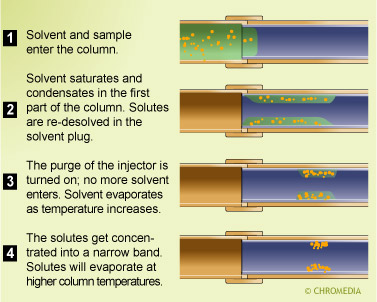Solvent effect
- Page ID
- 61221
It is surprising that the large volumes of solvent introduced onto the column in splitless and on-column injection do not cause any problems. If a small amount of liquid is introduced into the capillary column, it will be deposited as a film layer on the inner wall where the stationary phase is situated. The length of the column where the film layer is situated is the initial injection band. This bandwidth is, however, unacceptable. Fortunately a mechanism called solvent focusing or solvent effect sharpens the input band before the chromatographic process actually starts. This mechanism is illustrated in the figure below.
Solvent effect

The layer of condensed solvent evaporates from the rear. Analytes left on the now dry stationary phase start to move and are re-trapped in the shortening liquid film. This process continues until all analytes are present in the last bit of solvent. When that has also evaporated, the analytes are fully reconcentrated and start the separation as a narrow band.
For a good solvent effect, two requirements must be met:
- The initial oven temperature should be at least 15oC below the boiling point of the solvent
- The polarity of the solvent should be similar to that of the stationary phase, otherwise no homogeneous film is obtained.
Cold trapping occurs when the column temperature selected is so low that the solvent condenses at the top of the column and forms a retention obstacle for those sample components that are less volatile than the solvent. This results in narrowing of the injection band as the solvent evaporates due to the rising column temperature and the flow of carrier gas.
The solvent effect is induced by selecting a temperature that is at least 15 - 20°C lower than the boiling point of the solvent.
In order to avoid problems with the stationary phase in combination with a condensed liquid, the use of non-chemically bonded phases is excluded. Otherwise layer distortion, extraction etc. can occur. It is clear that both cold-trapping and solvent trapping occur at relatively low column temperatures.
For both cold trapping and solvent effect to occur, a temperature program is necessary to achieve an efficient chromatographic separation within a short analysis time. Temperature-programming goes hand in hand with splitless and on-column injection.
The solvent effect yield the best results for components with elution temperatures above 100 °C and with a difference between elution and column temperatures of at least 80°C.
Solvent effect on peak shape

This example illustrates the effect of choosing an initial column temperature above AND below the solvent boiling point. At an initial column temperature of 70oC n-hexane shows tailing of both solvent and analyte peaks. In case of a higher boiling solvent (n-octane) the peak shapes will improve considerably.

